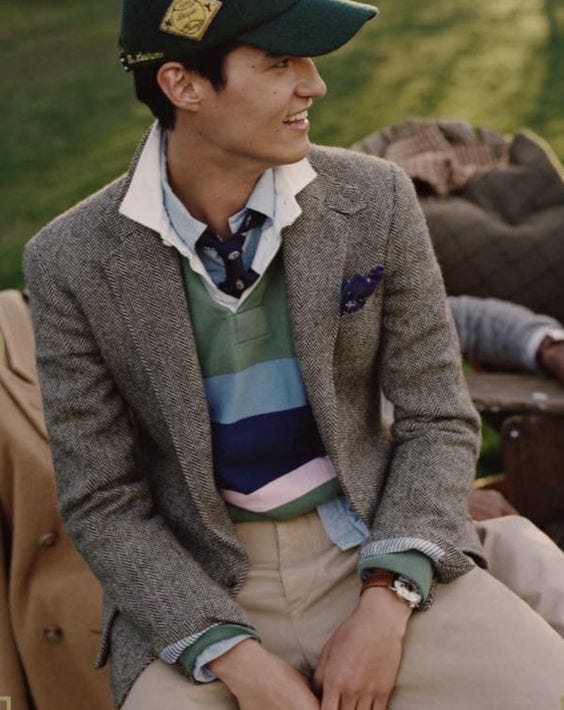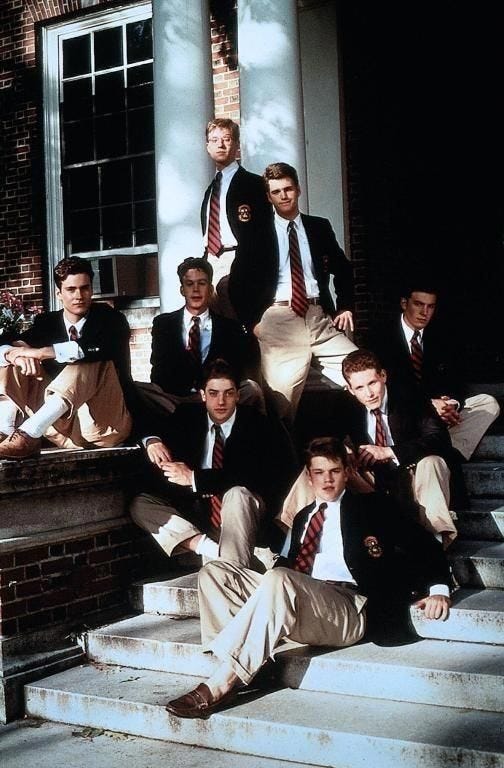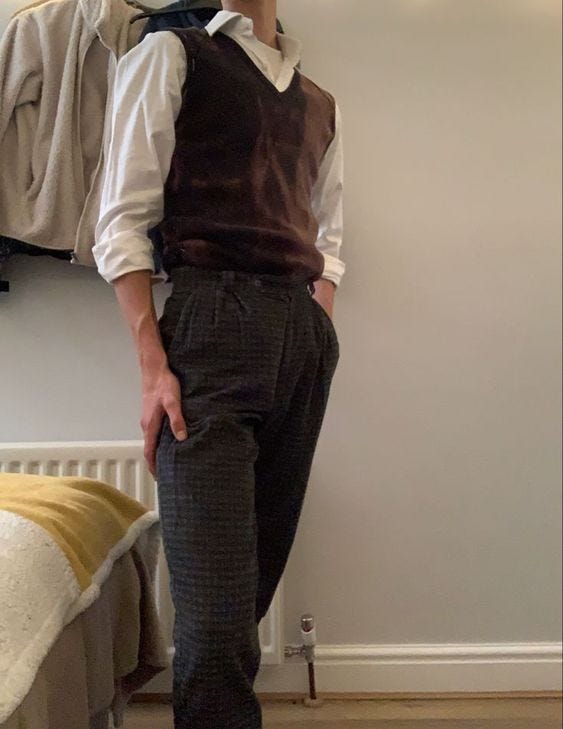The trio of terms present both in the subject matter of this meeting and the description for the club itself, are variations in expression for a number of styles with similar ideas at the very heart. The two former have a great deal of provenance, whilst the latter is a comparatively youthful and less pedigreed term. It is in their collective persistence that we find underlying threads which represent a perpetual desire to communicate certain ideas through clothing.
Allow me, if you might, to coin a term. I should like to refer to these types of dress collectively as the “collegiate styles”, I think this apt because it is their association with academic institutions which is their principal relation to one another, besides the similarities in the styles themselves.
I’d like to take a look at each of these, at how they're expressed today, at how they’ve influenced one another, in order to explore why we might love to dress like sexy history professors.
Ivy
The history of Ivy cannot be appropriately summarised in an article of this length, ivy-style.com has dedicated years to the documentation of its many phases and forms. It was perhaps defined at its inception by clothes sold by Brooks Brothers and J. Press, married to the culture at Ivy League colleges post WWII. Though the style has seen a number of less glamorous periods, the modern vision of Ivy seems to be returning to its earliest roots, characterised by a nostalgia for the colour palettes and silhouettes of the 40s and 50s.
Ivy’s greatest hits, as it were, are button-down Oxford shirts, penny loafers, soft-shouldered blazers, wide-leg khaki trousers. Pulling from its roots in American academia, another key aspect is the incorporation of sportswear. The ‘23 interpretation of this sporting infusion is perhaps characterised by rugby shirts and baseball caps alongside smart-casual suiting.
As I mentioned last week, Ivy seems to be a growing influence in the trending Americana styles of fashion enthusiasts. Vintage Brooks Brothers and Ralph Lauren pieces are becoming common sights, and whilst it might not be quite mainstream, its nice to see those engaging with Ivy expanding outside of the stereotypical clientele, the current revival is arguably why I’m here writing about it.
Prep
Considering prep and Ivy together first reveals a considerable overlap between the two, some might argue even that Ivy birthed prep. In my eyes, where Ivy has its roots in the 40s and 50s, prep, as it is known in the global consciousness, came about in the 1980s, with the growing popularity of the polo shirt, the founding of mail-order labels such as Lands End, L.L. Bean and J. Crew, and the launch of “the official preppy handbook”, which although intended to be tongue-in-cheek, quickly became ubiquitous in the states. Shortly thereafter brightly coloured prep outfits became the attire of the antagonistic forces in teen movies, the “prep” became an archetype.
The characteristic difference between prep and Ivy is a contextual one, as Christian Chensvold describes for Ivy Style. Where Ivy was the generally accepted dress code for students at its inception, those who dressed in prep attire did so out of choice, it is here that we encounter some of the problematical aspects of the early collegiate styles. Alongside their ties to exclusive education, the pricing of garments and labels considered “preppy” automatically made them a symbol of an upper-middle class, privileged upbringing. There still persists a collective perception, in part perhaps due to nostalgia for media which represented as such, that prep exists as a uniform which enforces a class divide. If one wants to wear these clothes, they must be considerate of this.
Prep exists as a development of Ivy, which it came to replace through the late 20th century, it refers predominantly to Ivy style refracted through the lens of 70s through to 90s trends. The general consensus is prep is more brightly coloured, but ultimately relies upon similar core pieces.
The Academias
Now, this is where the timeline ceases to be linear, “Dark Academia” is a style of dress which developed from online communities. Informed not by a direct bloodline from Ivy, but from an appreciation of and nostalgia for media which itself was informed by Ivy style. The seminal works for the “academia aesthetic” are Peter Weir’s Dead Poet’s Society and Donna Tartt’s The Secret History, the latter relying on description alone. Dark Academia exists as an aesthetic movement rather than just a style of dress, preoccupied with the romanticisation of study and an idealised vision of academic life. Most teen-founded online aesthetic movements feature some sort of expression of escapism.
As aforementioned, the clothing of Dark Academia doesn't have a direct bloodline from Ivy, and as such it differs, but another key difference is that it developed principally as a feminine interpretation of masculine presenting fashion, it exhibits very little consideration of the “rules of menswear”. The fashion itself focusses on knitwear as the base for most outfits, paired with dark formal trousers. Checked fabrics are popular, as are boots and loafers, though often a rubber sole such as a lug or Doc. Marten, such is the Gen Z uniform. “Dark Academia” gave way to variations in palette, “light” and “darkest”, unlike Ivy and prep though, bright colours are never employed, the palette is always greys, browns and muted greens. It also does not feature the infusion of sportswear present in Ivy, except perhaps the occasional cricket sweater. Looking back to Tartt’s description of clothing in her novel, the brands she mentions are not Brooks Brothers or J. Press but classic English and old-world American labels: Gieves and Hawkes, Sulka, Aquascutum, one might argue that the style as a whole features a more English style of dress, checked jackets and trousers, for example, and usually poplin shirts rather than oxfords.
The Threads Between Them
The lack of provenance of styles derived from online aesthetics perhaps leads them to be considered as unserious styles of dress, not worthy of consideration in publications. I disagree, Dark Academia as a development is very interesting, firstly, whilst Ivy is sort of Prep, and Prep is sort of Ivy, Academia is neither, it lacks key aspects that would make it such. So why is it so similar? I am now going to speculate.
There is firstly the aforementioned influence of Ivy and Prep on the medias from which Dark Academia is derived, the lineage exists, just not so directly. I cannot help but feel there is something more than that though, something about clothing with an association to existing in an academic institution. I have wondered as to whether there’s a particular positive connotation about it all, perhaps a sense of belonging in being a part of an institution, perhaps a love learning and that which is associated with it.
That sense of community certainly persists in the perception of those dressed in Prep attire as cliquey, well-off WASPs, there was a time when they were genuinely a part of a club that others could not afford to join (the irony is not lost on me, just so you know). Though the fashion has, to a certain extent, become democratised, there is still an archetypal prepster, the exclusive sports of polo and crew are woven into the brands which make the clothes, there is still a lifestyle connection with close ties to belonging. The dark academic though, is not the archetypal WASP, though probably still fits the acronym, rather they embody a dedicated student, usually of the liberal arts, and often solitary in their pursuit of knowledge. Since it is a fashion derived from media, the embodiment is that of a fictional character, rather than a real-world archetype.
There is this commonality of a romanticised view of campus living at the heart of these styles, I think that is a wonderful thing. The enduring nature of the collegiate styles acts as a thread between generations, their collective nostalgia, and love of learning. You could show the same outfit to three people of three generations and have it described as ivy, prep, or dark academia, the signifying differences pale in comparison to the unifying similarities.
As to why I chose Prep as the namesake of the publication, it rolls off the tongue nicely, there’s no particular preference there, if anything, prep is the label I use the least of the three when describing my fashion.
Thank you for taking the time to read this far today, this meeting has run much longer than those previous to it, it certainly isn’t a precedent, I simply found a lot to explore here. If you have any of your own thoughts on the labels we use in the realm of these styles, let me know.
Meeting adjourned, see you soon.












I perhaps have spent too long trying to articulate the instinctive sense of ‘difference’ I see in dark academia when compared with the other two styles. I seem to recall some meetings ago you mentioning that dressing well is so often associated with those of a particular social status and even political alignment, and I don’t think that it is any coincidence that the names of those styles which you note have something of a ‘pedigree’ take their names from the elite Ivy League universities and the private preparatory schools designed to ferry wealthy students into them.
Dark academia, I agree, is a ‘democratisation’ of those distinctive styles once exclusive to the upper and upper middle classes. I have met many people who have taken up this style of dress as a means of attaining the status that so often comes with it. I hope you won’t mind me using you as an example, but I see dark academia in part as the effort by those such as yourself to emulate parts of the aesthetic of Ivy and Prep but without also emulating the social status and privilege that comes with it. What draws me to your content is your effort to open the door to dressing well to all who may wish to do so, and where others would point to exclusive and unaffordable designers, you instead point to charity shops and affordable brands to put together one’s wardrobe.
However, I think dark academia has something more to it. I think beyond simply the democratisation of a once exclusive aesthetic, in some regards one could see it as a rejection certain aspects of modernity and the invention of something wholly new. The love, as you put it, for looking like a ‘sexy history professor’ and studying the liberal arts. The attraction to reading classic hardcover books in an old stone building with ivy-covered walls. The romanticisation of universities such as Oxford on this side of the pond or the likes of Yale over in the States. In all of that there is a yearning for the historic and traditional and in that there is a yearning for aspects of the typical ivy and prep lifestyle while rejecting the aspects which signal privilege, like opulence and networking sports. I would not wish to make presumptions about your own background, but I myself come from a working class background in the North West of England. I’ve still yet to embrace fully the manner of dress typical of what has become known as dark academia as it’s a big step to finally take, but the attraction of the aesthetic is principally the equal rejection of both the modern ‘shorts and t-shirts’ I was born into and the privilege and elitism that is associated with the older, more established styles.
As someone who's been trying to experiment with ivy looks in his personal style, this was so helpful and a great read. Thanks for this one Callum.